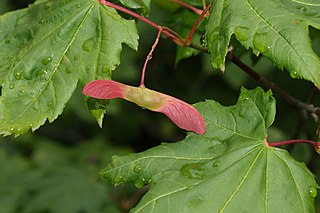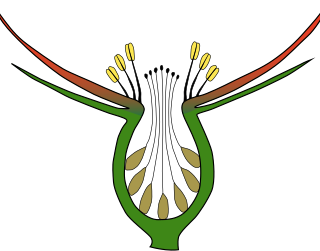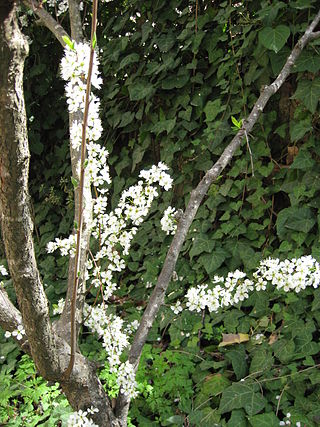
A samara is a winged achene, a type of fruit in which a flattened wing of fibrous, papery tissue develops from the ovary wall. A samara is a simple dry fruit, and is indehiscent. The shape of a samara enables the wind to carry the seed further away from the tree than regular seeds would go, and is thus a form of anemochory.

A sepal is a part of the flower of angiosperms. Usually green, sepals typically function as protection for the flower in bud, and often as support for the petals when in bloom.

In botany, a capsule is a type of simple, dry, though rarely fleshy dehiscent fruit produced by many species of angiosperms.

An achene, also sometimes called akene and occasionally achenium or achenocarp, is a type of simple dry fruit produced by many species of flowering plants. Achenes are monocarpellate and indehiscent. Achenes contain a single seed that nearly fills the pericarp, but does not adhere to it. In many species, what is called the "seed" is an achene, a fruit containing the seed. The seed-like appearance is owed to the hardening of the fruit wall (pericarp), which encloses the solitary seed so closely as to seem like a seed coat.

The pomelo, also known as a shaddock and from the family Rutaceae, is the largest citrus fruit. It is an ancestor of several cultivated citrus species, including the bitter orange and the grapefruit. It is a natural, non-hybrid, citrus fruit, native to Southeast Asia. Similar in taste to a sweet grapefruit, the pomelo is commonly eaten and used for festive occasions throughout Southeast and East Asia. As with the grapefruit, phytochemicals in the pomelo have the potential for drug interactions.

A pyrena or pyrene is the fruitstone within a drupe or drupelet produced by the ossification of the endocarp or lining of the fruit. It consists of a hard endocarp tissue surrounding one or more seeds. The hardened endocarp which constitutes the pyrene provides a protective physical barrier around the seed, shielding it from pathogens and herbivory.

Dehiscence is the splitting of a mature plant structure along a built-in line of weakness to release its contents. This is common among fruits, anthers and sporangia. Sometimes this involves the complete detachment of a part. Structures that open in this way are said to be dehiscent. Structures that do not open in this way are called indehiscent, and rely on other mechanisms such as decay or predation to release the contents.

An aggregate fruit or etaerio is a fruit that develops from the merger of several ovaries that were separated in a single flower. In contrast, a simple fruit develops from one ovary, and a multiple fruit develops from multiple flowers. In languages other than English, the meanings of "aggregate" and "multiple" fruit are reversed, so that "aggregate" fruits merge several flowers. The differences in meaning are due to a reversal in the terminology by John Lindley, which has been followed by most English-language authors.

Multi-fruits, also called collective fruits, are fruiting bodies formed from a cluster of flowers, the inflorescence. Each flower in the inflorescence produces a fruit, but these mature into a single mass. After flowering, the mass is called an infructescence. Examples are the fig, pineapple, mulberry, osage orange, and jackfruit.
A fenestra is any small opening or pore, commonly used as a term in the biological sciences. It is the Latin word for "window", and is used in various fields to describe a pore in an anatomical structure.

A schizocarp is a dry fruit that, when mature, splits up into mericarps.

In botany, a peduncle is a stalk supporting an inflorescence or a solitary flower, or, after fecundation, an infructescence or a solitary fruit. The peduncle sometimes has bracts at nodes. The main axis of an inflorescence above the peduncle is the rachis. There are no flowers on the peduncle but there are flowers on the rachis.

In botany, a berry is a fleshy fruit without a stone (pit) produced from a single flower containing one ovary. Berries so defined include grapes, currants, and tomatoes, as well as cucumbers, eggplants (aubergines), persimmons and bananas, but exclude certain fruits that meet the culinary definition of berries, such as strawberries and raspberries. The berry is the most common type of fleshy fruit in which the entire outer layer of the ovary wall ripens into a potentially edible "pericarp". Berries may be formed from one or more carpels from the same flower. The seeds are usually embedded in the fleshy interior of the ovary, but there are some non-fleshy exceptions, such as Capsicum species, with air rather than pulp around their seeds.
This glossary of botanical terms is a list of definitions of terms and concepts relevant to botany and plants in general. Terms of plant morphology are included here as well as at the more specific Glossary of plant morphology and Glossary of leaf morphology. For other related terms, see Glossary of phytopathology, Glossary of lichen terms, and List of Latin and Greek words commonly used in systematic names.

In botany, sessility is a characteristic of plant organs such as flowers or leaves that have no stalk. Plant parts can also be described as subsessile, that is, not completely sessile.

Water sprouts or water shoots are shoots that arise from the trunk of a tree or from branches that are several years old, from latent buds. The latent buds might be visible on the bark of the tree, or submerged under the bark as epicormic buds. They are sometimes called suckers, although that term is more correctly applied to shoots that arise from below ground, from the roots, and a distance from the trunk.

Rhus coriaria, commonly called Sicilian sumac, tanner's sumach, or elm-leaved sumach, is a deciduous shrub to small tree in the cashew family Anacardiaceae. It is native to southern Europe and western Asia. The dried fruits are used as a spice, particularly in combination with other spices in the mixture called za'atar.

In botany, a whorl or verticil is a whorled arrangement of leaves, sepals, petals, stamens, or carpels that radiate from a single point and surround or wrap around the stem or stalk. A leaf whorl consists of at least three elements; a pair of opposite leaves is not called a whorl.
Amphicarpy is a reproductive strategy that occurs with 13 plant families, expressed mostly in species with an annual life cycle. It is characterized by production of two types of fruit, for different ecological roles. It is sometimes restricted to the situation where one fruit type is aerial and the other subterranean (hypogeous), and similar to, but distinguished from, heterocarpy, which latter means a plant that carries two distinct types of fruit or seeds. The word amphicarp is the contraction of the Greek words ἀμφί meaning "of both kinds" and καρπός meaning fruit.
Desmodium perplexum is a species of flowering plant in the legume family Fabaceae. It is native to eastern North America. The specific name perplexum refers to the confusion surrounding this species since its initial description in 1950.
















